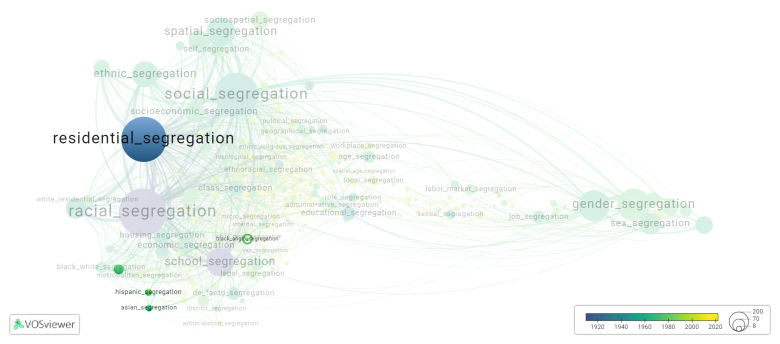Black anglo segregation: Difference between revisions
(Creating page) |
(Creating page) |
||
| Line 13: | Line 13: | ||
Black anglo segregation is frequently discussed in the literature with the following segregation forms: | Black anglo segregation is frequently discussed in the literature with the following segregation forms: | ||
[[ | [[residential segregation]], [[black segregation]] | ||
[[File:black_anglo_segregation.png|780x780px]] | [[File:black_anglo_segregation.png|780x780px]] | ||
| Line 19: | Line 19: | ||
For the complete network of associated segregation forms, see: | For the complete network of associated segregation forms, see: | ||
year of publication https://tinyurl.com/2235lkhw | |||
Louvain clusters https://tinyurl.com/2d8wg5n3 | |||
betweenness centrality https://tinyurl.com/223udk5r | |||
disciplines where segregation forms first appeared https://tinyurl.com/244d8unz | |||
==References== | ==References== | ||
==Notes== | ==Notes== | ||
Revision as of 14:33, 27 September 2024
Date and country of first publication[1]
1987
United States
Definition
Black Anglo segregation refers to the historical separation and exclusion of Black individuals or communities within predominantly white Anglo areas. This form of segregation was prevalent during the period of Jim Crow laws in the United States, which enforced racial segregation and discrimination.
During this time, Black individuals were legally prohibited from residing, working, or attending schools in white Anglo neighborhoods. Black neighborhoods often had limited resources, inferior public services, and unequal educational opportunities. Black individuals faced systemic racism and social, economic, and political marginalization as a result of this segregation.
While legal segregation has been abolished in the United States, the effects of Black Anglo segregation can still be seen today. Residential segregation persists in many American cities, with predominantly Black neighborhoods experiencing higher poverty rates, limited access to quality education, and increased police presence. These inequalities contribute to a cycle of disadvantage and perpetuate racial disparities. Overcoming the legacy of Black Anglo segregation requires addressing systemic racism and implementing policies that promote equality and inclusion.
See also
Related segregation forms
Black anglo segregation is frequently discussed in the literature with the following segregation forms:
residential segregation, black segregation

For the complete network of associated segregation forms, see:
year of publication https://tinyurl.com/2235lkhw
Louvain clusters https://tinyurl.com/2d8wg5n3
betweenness centrality https://tinyurl.com/223udk5r
disciplines where segregation forms first appeared https://tinyurl.com/244d8unz
References
Notes
- ↑ Date and country of first publication as informed by the Scopus database (December 2023).
At its current state, this definition has been generated by a Large Language Model (LLM) so far without review by an independent researcher or a member of the curating team of segregation experts that keep the Segregation Wiki online. While we strive for accuracy, we cannot guarantee its reliability, completeness and timeliness. Please use this content with caution and verify information as needed. Also, feel free to improve on the definition as you see fit, including the use of references and other informational resources. We value your input in enhancing the quality and accuracy of the definitions of segregation forms collectively offered in the Segregation Wiki ©.
Black anglo segregation appears in the following literature
Massey D.S., Denton N.A. (1987). Trends in the residential segregation of blacks, Hispanics, and Asians: 1970 1980. American Sociological Review, 52(6), 802-825. https://doi.org/10.2307/2095836
